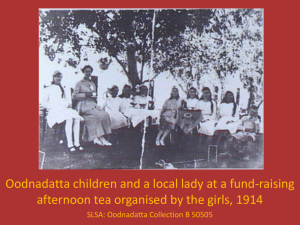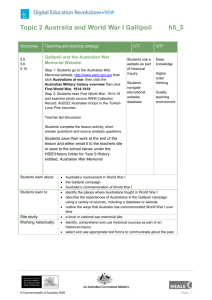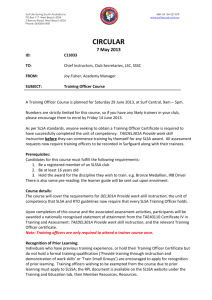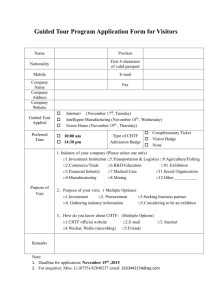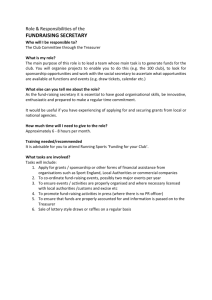Powerpoint slides part 1
advertisement
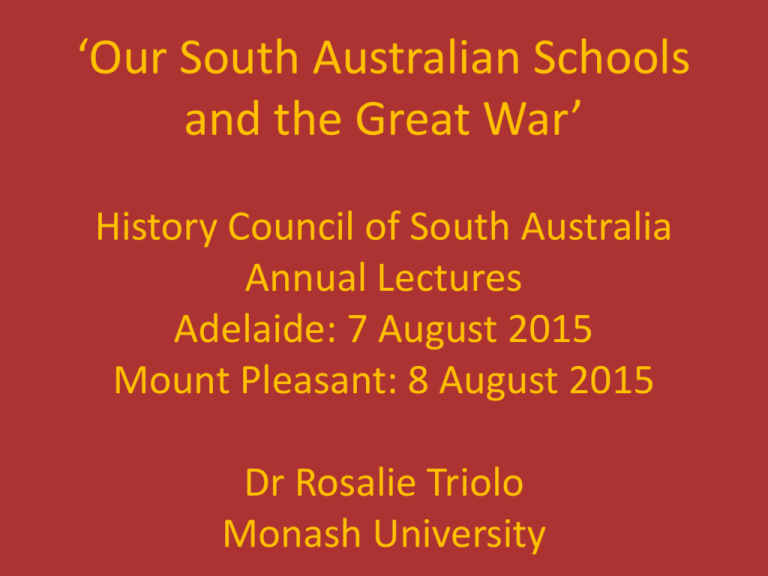
‘Our South Australian Schools and the Great War’ History Council of South Australia Annual Lectures Adelaide: 7 August 2015 Mount Pleasant: 8 August 2015 Dr Rosalie Triolo Monash University The research trail begins with a photograph • Perth State School, Tasmania, 1916 – four children from one family. By the time the photograph has been taken, they have lost one older brother in the Great War. In 1918, they lose a second brother … • Two teachers of 81 students – what are those teachers’ wartime experiences, including their challenges with loved ones or teacher-colleagues serving overseas? What are the wartime experiences of other children in the photograph? ‘[S]chools waiting anxiously for the men to return are … “unfamous history”.’ John Fox, Forgotten Divisions: The First World War from Both Sides of No Man’s Land, Sigma, Cheshire, 1994, p vi ‘The Children’s Hour’ * First ‘number’ published in March 1889, 4 pages, ½d * Last number, December 1963 * Compulsory reading so ‘every child would have approved – and inexpensive - material from which to read and learn …’ * Contained formal officially approved knowledge, and expected values, attitudes and behaviours * Teachers were expected to use it * Inspectors ‘checked’ * Tens of thousands were issued over the period and entered all government schools, most independent, many Catholic and Lutheran * Now ‘very rare’ … Other major sources for ‘Schooling, Service and the Great War’ and today’s presentation: * Heather Bonnin, Hours to Remember: Reflections on Life in South Australia, 1889-1929 from ‘The Children’s Hour’, SAGP, Netley, 1987 * Jacqueline Kent, In the Half Light: Reminiscences of Growing up in Australia, 1900-1970, Doubleday, Sydney, 1992 * Elizabeth Kwan, Flag and Nation: Australians and their National Flag since 1901, UNSWP, Sydney, 2006 * Elizabeth Kwan, ‘Making “Good Australians”’, JAS, no 29, Jun 1991 * Janice Pavils, ‘The emergence of SA Anzac Culture, 1915-1925’, JRAHS, vol 89, no 2, Dec. 2003 * Colin Thiele, Grains of Mustard Seed: A Narrative of State Education in South Australia: 1875-1975, Education Department SA, Adelaide, 1975 * Rosalie Triolo, ‘Our Schools and the War’, Australian Scholarly, Kew, 2012 More generally … * Australian War Memorial - online * State Library of South Australia – online * Australian National Museum of Education collection at the University of Canberra * SA school histories available in Victoria Availabilities of sources: government vs independent, Catholic, Lutheran, Quaker … What did South Australian students learn during the Great War about the British Empire, its Allies and its Enemies? Empire Day, 24 May, Rhine Villa (later Cambrai) School, 1905 SLSA: B 34275 Empire Day, Coonalpyn School, 1906 SLSA: B 36887 ‘Saluting the flag’, Free Kindergarten, Adelaide, 1912 SLSA: Searcy Collection PRG 280/1/6/354 Empire Day, Pyap West School, 1914 from ‘The Children’s Hour’, in Heather Bonnin, Hours to Remember, p 105 Girls of Sturt St School, Adelaide, dressed as the peoples of Australia, Empire Day, 1915 SLSA: PRG 280/1/10/431 Caricature of King George V: JH Chinner Australian War Memorial (AWM): ART96320 British General Douglas Haig: JH Chinner AWM: ART96322 British Admiral John Jellicoe: JH Chinner AWM: ART96321 French General Joseph Joffre: JH Chinner AWM: ART96317 French Field Marshall Ferdinand Foch: JH Chinner AWM: ART96323 ‘Show and Tell’? French Souvenir Sachet, sent to Janet and Theodora Ekers, by Pte Frank Botten of Prospect, SA AWM: REL42738.001 ‘The Bank of Thrift’, erected in front of Government House, to encourage war loans: ‘Vive La France’, North Terrace, 1915 SLSA: North Terrace Collection B 61736 School children at ‘The Bank of Thrift’: ‘Vive La France’, North Terrace, 1915 SLSA: Searcy Collection PRG 280/1/15/766 The Bank of Thrift: ‘Help Wounded France’, North Terrace, 1915 SLSA: Searcy Collection PRG 280/1/15/237 Children of the North Shields School, Empire Day, 1912 SLSA: B 54026 SA children dressed in the national costumes of other countries, almost certainly at a patriotic event, location unknown, 1917 SLSA: Searcy Collection PRG 280/1/15/561 The Germans? ‘German Flat to be known as Benara Flat. Gnadenfrei to be known as Marananga. Hermann’s Landing to be known as Moramora.’ South Australia Education Department, in Thiele, p 132 At Prince Alfred College, some families with German surnames changed their names: ‘Mahnke became Jones, Kreusler became Waterford, Schmelzkopf became South’. Ron Gibbs, A History of Prince Alfred College, Peacock, Kent Town, 1984, p 169 At one school, a 13-year-old boy had the following poem published in the school magazine: ‘You awful, murderous, “Kultur’d’ swine, We’ll drive and rout you over the Rhine; We’ll beat you round and up and down; We’ll beat you out of every town!” (Gibbs, p 170) SA Lutheran schools closed in 1917 Attitudes in many schools to ‘the Germans’ … ‘Rather than hate your enemy, love your Empire all the more …’ What patriotic activities did many students and teachers perform on the home front during the Great War, and why? ‘Everyone and everything helps the Cause’, 1917 SLSA: Searcy Collection PRG 280/1/15/561 Hog Bay School, girls and boys knitting, 1917 from ‘The Children’s Hour’, in Bonnin, p 105 Boys of Quorn School, knitting, 1916 from ‘The Children’s Hour’, in Bonnin, p 105 Small fund-raising badge, made in South Australia, c 1916-18 AWM: REL39133 Small fund-raising badge, made in South Australia, 1918 AWM: REL39114 Small fund-raising badge, made in South Australia, 1918-19 AWM: REL39132 Small fund-raising badge, made in South Australia, 1917 AWM: REL39109 Small fund-raising badge, sold in support of homes on the Myrtlebank site for repatriated SA soldiers, c 1916-18 AWM: REL34062 Small fund-raising badge, sold in support of homes on the Myrtlebank site for repatriated SA soldiers c 1917-18 AWM: REL39110 Small fund-raising badge, sold in support of homes on the Myrtlebank site for repatriated SA soldiers, c 1916-19 AWM: REL34060 Small fund-raising badge, sold in support of homes on the Myrtlebank site for repatriated SA soldiers, 1919 AWM: REL34061 Small fund-raising badge, sold in support of homes on the Myrtlebank site for repatriated SA soldiers, 1919 AWM: REL34057 Small fund-raising badge, made in South Australia, c 1918 AWM: REL33174 Patriotic fund-raising Australia Day silk ribbon, made in South Australia, 1916 AWM: REL37725 Cardboard and fine-ribboned fund-raising badge honouring SA Anzac units, 1914-18, made in South Australia, 1918 AWM: REL39138 Celluloid-coated paper fund-raising badge with ribbon, made in South Australia for ‘Remembrance Day, 1918’ (being Anzac Day), 1918 AWM: REL39139 Girl and women badge sellers at a SA patriotic fete, location unknown, c 1918 SLSA: Searcy Collection PRG 280/1/15/504 ‘Schoolgirl flower sellers’. Paskeville School, 1916 from ‘The Children’s Hour’, in Bonnin, p 110 Burdett School girls and boys selling flowers on Arbor (Tree) Day, 1916 from ‘The Children’s Hour’, in Bonnin, p. 75 Women, girls and boys at Mt. Gambier selling fund-raising wattle blossom, 1914 SLSA: Searcy Collection PRG 280/1/13/365 Tickera School children in the school garden, 1915 from ‘The Children’s Hour’, in Bonnin, p. 76 Eudunda School children in the school garden, 1917 from ‘The Children’s Hour’, in Bonnin, p. 76 Gilles Plains school children with horse nets they have made to keep flies out of army horses’ eyes in the Middle East, c 1916 SLSA: Gilles Plains Collection B 55267 Sandbags made by Heathfield School pupils, 1916 from ‘The Children’s Hour’, in Bonnin, p 112
